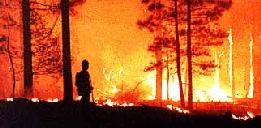High Alert Institute
Fiddling as America Burns

Emergency Managers, Contingency Planners and Disaster Preparedness Educators nation wide sing a common refrain, the need for a coordinated disaster preparedness effort is not news. The need for meaningful and effective disaster preparedness funding is not a recent revelation. The Institute of Medicine and later the National Academies of Science have published a total of 3 reports calling for increased funding, more coordinated planning, effective and meaningful drills and the widespread adoption of High Fidelity Immersion Simulation by the medical community and the rest of the disaster response community. Outspoken advocates for the American people form a cacophonous symphony of concern. But is anyone listening as this band plays on?!
In the past it has been painfully obvious that those in the private sector in charge of spending on preparedness have been unwilling or unable to invest in this most critical of priorities. Some hospitals have begun to invest in the education and the equipment, but most have not. Even fewer major American corporations have “seen the light.”
There have been some shining stars:
- The National Disaster Life Support Foundation has created a series of courses often characterized as “The CPR of the 21st Century.”
- The American Board of Disaster Medicine has awarded Board Certification for Physicians in Disaster Medicine
- Training for disaster preparedness has moved from the university environment to become a growth industry in the private sector
- The National Center for Biodefense Solutions, Inc.
- Nationals Disaster Life Support of Florida, Inc.
- Burgess and Associates, Inc.
- The State of Texas has created the Texas Medical Rangers as a disaster medical reserve corps.
But more is needed:
- A commitment by corporate healthcare to Disaster Preparedness and Community Emergency Response Integration regardless of whether grant funding is available.
- An understanding that Disaster Preparedness is a personal, family, community, business and healthcare responsibility, independent and separate from the Federal responsibility.
- An acceptance of the financial responsibility for personal, family, community, business and healthcare preparedness.
What can you do when disaster strikes?
Well, if you didn’t prepare ahead:
- Don’t panic – this is easier said than done. With a few must-haves you’ll be able to survive at least 72 hours. By then communications should be back up and help will be on its way.
- Use common sense – if it ain’t yours, don’t touch it. If the power line that fell is not yours don’t touch it, if the stray dog isn’t yours don’t touch it. This will help you remain safe.
- Work smart, not hard – it is hot, you are limited on your water. Work in the early hours, sleep under your tarp mid-day, work in the evening when its cooler again.
- Don’t wander – wherever you are from, you know the dangers there. This is not the time to learn something new. See rule one.
- Seek help – talk to neighbors, friends, and other family members, don’t go it alone. There is safety and strength in numbers.
But since it is always better to plan ahead, here is a short list of “must-haves:”
- Tarp, not for your roof – if you’re outside you can create shade; if your shelter is gone, it provides shelter; and condensation to collect and cool drinking water.
- Crank or shake type flashlight – when its’ still overcast and no moon nothing is darker than dark.
- Crank type radio with cell phone charger – receive information and send messages through wireless.
- First aid kit – small personal ones for each person in the family that you can carry in a backpack.
- Backpack packed before disaster strikes – list of basic can be forwarded.
- Water – most people think food and water, but this one is left until the end on purpose. Obesity is found in more than 50% of the population. Most can live off what they have stored for 3 – 5 days. However water is not stored in the human body, it must be replenished. Two gallons per person per day is ideal which will cover only drinking, not flushing or washing; two quarts is minimum.
With these few steps, you can ensure that while others are fiddling, you are thriving.
High Alert Institute
4800 Ben Hill Trail
Lake Wales, FL 33898
Office: 863.696.8090
FAX: 407.434.0804
EIN: 27-5078437
Info@HighAlertInstitute.org
Privacy Policy
Cookie Policy
Terms of Use
Disclaimers
Get Your Data
Shipping Policy
Message Us
Transparency
Registrations
Do Not Sell Info
Return Policy
A COPY OF THE OFFICIAL REGISTRATION AND FINANCIAL INFORMATION MAY BE OBTAINED FROM THE DIVISION OF CONSUMER SERVICES BY CALLING TOLL-FREE, WITHIN THE STATE, 1-800-435-7352 (800-HELP-FLA), OR VISITING www.FloridaConsumerHelp.com. REGISTRATION DOES NOT IMPLY ENDORSEMENT, APPROVAL, OR RECOMMENDATION BY THE STATE. Florida Registration #CH68959
REGISTRATION WITH A STATE AGENCY DOES NOT CONSTITUTE OR IMPLY ENDORSEMENT, APPROVAL OR RECOMMENDATION BY THAT STATE.










